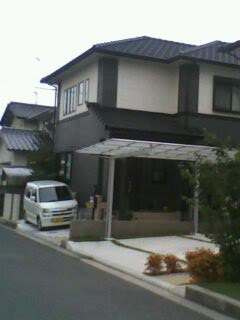


The usual residential area found in Kusatsu - Nigoshi in Hiroshima. Houses are built with exterior and interior designs. And commonly, there are good cars parked on each resident.
June 25, 2009
Kusatsu - Nigoshi
by:
Rendell
6
comments
![]()
Labels: place
June 22, 2009
On a single realization...
When you go on a place for the first time, for sure you will be thinking of a lot of things most especially when you are alone, plenty of expectations and (maybe) hesitations if you don't have the courage. .
Sa airport pa lng, patingin.tingin na ako kung ano tlaga itsura ng Japan. Nasa isip ko talaga, high.tech facilities yung nakapalibot at matataas na gusali. Eh, totoo nga, may mga automatic bukas na mga taxi at buses at matatayog na mga gusali. Pero sabi nila, ordinaryong siyodad nga lng daw ang Fukuoka at Hiroshima kumpara sa Tokyo.
Pagkalabas ko sa arrival lobby pagkatapos ng final inspection regarding a h1n1, nkasalabong ko na agad yung naghihintay ko na sundo. Isa din kasamahan na Pinoy sa trabaho. Mula doon, sakay kami ng bus (bus na bumibayahe lng sa loob ng compound ng airport), and as expected nasa bandang kanan ang driver seat at baliktad talaga yung kalsada. Papunta kami sa istasyon ng tren kung saan magdadala samin sa shinkansen train station, isa sa mga bullet train station na pawang kilala sa Japan. Pagnasa Japan ka talaga, kung gusto mubumiyahe from City to City, either mgba-bus ka (matagal) or yung long distance travel ng bullet train na aabutinn lng ng isang oras o mahigit depende sa lugar na puputahan. Yung biyahe namin eh diretso na sa may centro ng Hiroshima kng saan may maraming tren na umiikot at bumibiyahe sa buong lungsod.
Sa japan, pangkaraniwang transportasyon ng mga tao ay tren, bus, taxi, sariling sasakyan at bisiklita. Madalas kahit matatanda na, eh nagbibisiklita parin sa kalsada, yun na yung nakasanayan sa buong Japan. Tulad ng MRT at LRT sa Manila, ganun parin yung tren sa Hiroshima kaso mas malalayo lang yung iniikot ng tren. Halos lahat na ng sulok ng Hiroshima ay dinadaan na ng reles. Sa lungsod ng Hiroshima, wala masyadong pinoy akong nakita hindi daw tulad nung nasa Tokyo.
Anyway, the real score of this post is about why there is difference on Japan. On that very first day that I was traveling the major streets of Hiroshima, I instantly figured it out why. The streets are really clean. On around four days of my stay in the place, it is not only on the main streets that are clean but almost everywhere. The garbages are kept organized, and disposed on proper place and time and segregated accordingly. Even at the apartment where I stays, they are all practicing the same.
On the company where I belong and as they say to other Japanase companies, every morning the usual first session that employees and even the employers do is cleaning the work site. Even at the formal attire, we clean with rugs and brooms. Actually, my very first assignment was removing the grasses near the parking space together with some Japanese co-worker. There are no janitors. They truly work.
And this shows discipline. Discipline truly make sense. With this aspect, you can see how progressive their country is. And this is very mean.
In fact, I also observe their strict compliance on the traffic policies (less/no traffic actually).
(And this could be just the first realization, it may differ)
by:
Rendell
2
comments
![]()
June 18, 2009
Davao to Hiroshima
It was 6.30 in the morning, when i got the first flight from Davao. It was cebu pacific. The destination was Manila since their is no international flight direct Davao to Japan. It was around 8.15 when i reached the terminal 3 of NAIA (Ninoy Aquino International Airport). Then from Manila I took another flight heading Japan. Hiroshima City currently has no international flight direct from Manila, so I need to get a flight to a nearer city and it is Fukuoka. So the next flight was Manila - Fokuoka. The departure time was 10.15.. And around 3.20 (Japan Time) in the afternoon when I safely reached Fukuoka international airport. My very first OC (out of country). It was actually 4 hours of travel, not 5 since Japan time is about 1 hour ahead over the Philippine time. From there, we commute on a bus going to a train station. Then around 20 minutes of a train until we reached shinkansen train station. From there, we travel using the ideal train of japan, the bullet train heading to the city of Hiroshima. It was an hour of nonstop travel, so you can imagine how far is Fukuoka to Hiroshima. From the downtown of Hiroshima, we travel again by a round routing train to get to our proper place in Hiroshima, which is Nishi-ku.I reached the apartment where I will be spending most of the time in Japan very tired.
by:
Rendell
1 comments
![]()
Labels: out of county experience
